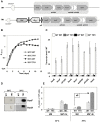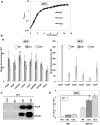Engineering Synechocystis PCC6803 for hydrogen production: influence on the tolerance to oxidative and sugar stresses
- PMID: 24586727
- PMCID: PMC3933540
- DOI: 10.1371/journal.pone.0089372
Engineering Synechocystis PCC6803 for hydrogen production: influence on the tolerance to oxidative and sugar stresses
Abstract
In the prospect of engineering cyanobacteria for the biological photoproduction of hydrogen, we have studied the hydrogen production machine in the model unicellular strain Synechocystis PCC6803 through gene deletion, and overexpression (constitutive or controlled by the growth temperature). We demonstrate that the hydrogenase-encoding hoxEFUYH operon is dispensable to standard photoautotrophic growth in absence of stress, and it operates in cell defense against oxidative (H₂O₂) and sugar (glucose and glycerol) stresses. Furthermore, we showed that the simultaneous over-production of the proteins HoxEFUYH and HypABCDE (assembly of hydrogenase), combined to an increase in nickel availability, led to an approximately 20-fold increase in the level of active hydrogenase. These novel results and mutants have major implications for those interested in hydrogenase, hydrogen production and redox metabolism, and their connections with environmental conditions.
Conflict of interest statement
Figures





Similar articles
-
Construction of a chassis for hydrogen production: physiological and molecular characterization of a Synechocystis sp. PCC 6803 mutant lacking a functional bidirectional hydrogenase.Microbiology (Reading). 2012 Feb;158(Pt 2):448-464. doi: 10.1099/mic.0.052282-0. Epub 2011 Nov 17. Microbiology (Reading). 2012. PMID: 22096147
-
The AbrB2 autorepressor, expressed from an atypical promoter, represses the hydrogenase operon to regulate hydrogen production in Synechocystis strain PCC6803.J Bacteriol. 2012 Oct;194(19):5423-33. doi: 10.1128/JB.00543-12. Epub 2012 Aug 3. J Bacteriol. 2012. PMID: 22865847 Free PMC article.
-
Overproduction of the cyanobacterial hydrogenase and selection of a mutant thriving on urea, as a possible step towards the future production of hydrogen coupled with water treatment.PLoS One. 2018 Jun 7;13(6):e0198836. doi: 10.1371/journal.pone.0198836. eCollection 2018. PLoS One. 2018. PMID: 29879209 Free PMC article.
-
Advances in the function and regulation of hydrogenase in the cyanobacterium Synechocystis PCC6803.Int J Mol Sci. 2014 Oct 31;15(11):19938-51. doi: 10.3390/ijms151119938. Int J Mol Sci. 2014. PMID: 25365180 Free PMC article. Review.
-
Current state and perspectives in hydrogen production by Escherichia coli: roles of hydrogenases in glucose or glycerol metabolism.Appl Microbiol Biotechnol. 2018 Mar;102(5):2041-2050. doi: 10.1007/s00253-018-8752-8. Epub 2018 Jan 24. Appl Microbiol Biotechnol. 2018. PMID: 29368215 Review.
Cited by
-
From Cyanobacteria to Human, MAPEG-Type Glutathione-S-Transferases Operate in Cell Tolerance to Heat, Cold, and Lipid Peroxidation.Front Microbiol. 2019 Sep 27;10:2248. doi: 10.3389/fmicb.2019.02248. eCollection 2019. Front Microbiol. 2019. PMID: 31681188 Free PMC article.
-
Comparative Genomics of DNA Recombination and Repair in Cyanobacteria: Biotechnological Implications.Front Microbiol. 2016 Nov 9;7:1809. doi: 10.3389/fmicb.2016.01809. eCollection 2016. Front Microbiol. 2016. PMID: 27881980 Free PMC article. Review.
-
The influence of electron utilization pathways on photosystem I photochemistry in Synechocystis sp. PCC 6803.RSC Adv. 2022 May 16;12(23):14655-14664. doi: 10.1039/d2ra01295b. eCollection 2022 May 12. RSC Adv. 2022. PMID: 35702219 Free PMC article.
-
Genetic, Genomics, and Responses to Stresses in Cyanobacteria: Biotechnological Implications.Genes (Basel). 2021 Mar 29;12(4):500. doi: 10.3390/genes12040500. Genes (Basel). 2021. PMID: 33805386 Free PMC article. Review.
-
A Genetic Toolbox for the New Model Cyanobacterium Cyanothece PCC 7425: A Case Study for the Photosynthetic Production of Limonene.Front Microbiol. 2020 Sep 18;11:586601. doi: 10.3389/fmicb.2020.586601. eCollection 2020. Front Microbiol. 2020. PMID: 33042102 Free PMC article.
References
-
- Grigorieva G, Shestakov S (1982) Transformation in the cyanobacterium Synechocystis sp 6803. FEMS Microbiol Lett 13: 367–370.
-
- Ferino F, Chauvat F (1989) A promoter-probe vector-host system for the cyanobacterium, Synechocystis PCC6803. Gene 84: 257–266. - PubMed
-
- Mermet-Bouvier P, Chauvat F (1994) A conditional expression vector for the cyanobacteria Synechocystis sp. strains PCC6803 and PCC6714 or Synechococcus sp. strains PCC7942 and PCC6301. Curr Microbiol 28: 145–148. - PubMed
Publication types
MeSH terms
Substances
LinkOut - more resources
Full Text Sources
Other Literature Sources

